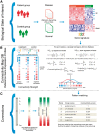A review of connectivity map and computational approaches in pharmacogenomics
- PMID: 28069634
- PMCID: PMC5952941
- DOI: 10.1093/bib/bbw112
A review of connectivity map and computational approaches in pharmacogenomics
Erratum in
-
A review of connectivity map and computational approaches in pharmacogenomics.Brief Bioinform. 2017 Sep 1;18(5):903. doi: 10.1093/bib/bbx023. Brief Bioinform. 2017. PMID: 28334173 Free PMC article. No abstract available.
Abstract
Large-scale perturbation databases, such as Connectivity Map (CMap) or Library of Integrated Network-based Cellular Signatures (LINCS), provide enormous opportunities for computational pharmacogenomics and drug design. A reason for this is that in contrast to classical pharmacology focusing at one target at a time, the transcriptomics profiles provided by CMap and LINCS open the door for systems biology approaches on the pathway and network level. In this article, we provide a review of recent developments in computational pharmacogenomics with respect to CMap and LINCS and related applications.
Figures
References
-
- Wang H, Gu Q, Wei J, et al.Mining drug–disease relationships as a complement to medical genetics-based drug repositioning: where a recommendation system meets genome-wide association studies. Clin Pharmacol Ther 2015;97(5):451–4. - PubMed
-
- Lamb J, Crawford ED, Peck D, et al.The connectivity map: using gene-expression signatures to connect small molecules, genes, and disease. Science 2006;313(5795):1929–35. - PubMed
Publication types
MeSH terms
Substances
Grants and funding
LinkOut - more resources
Full Text Sources
Other Literature Sources


